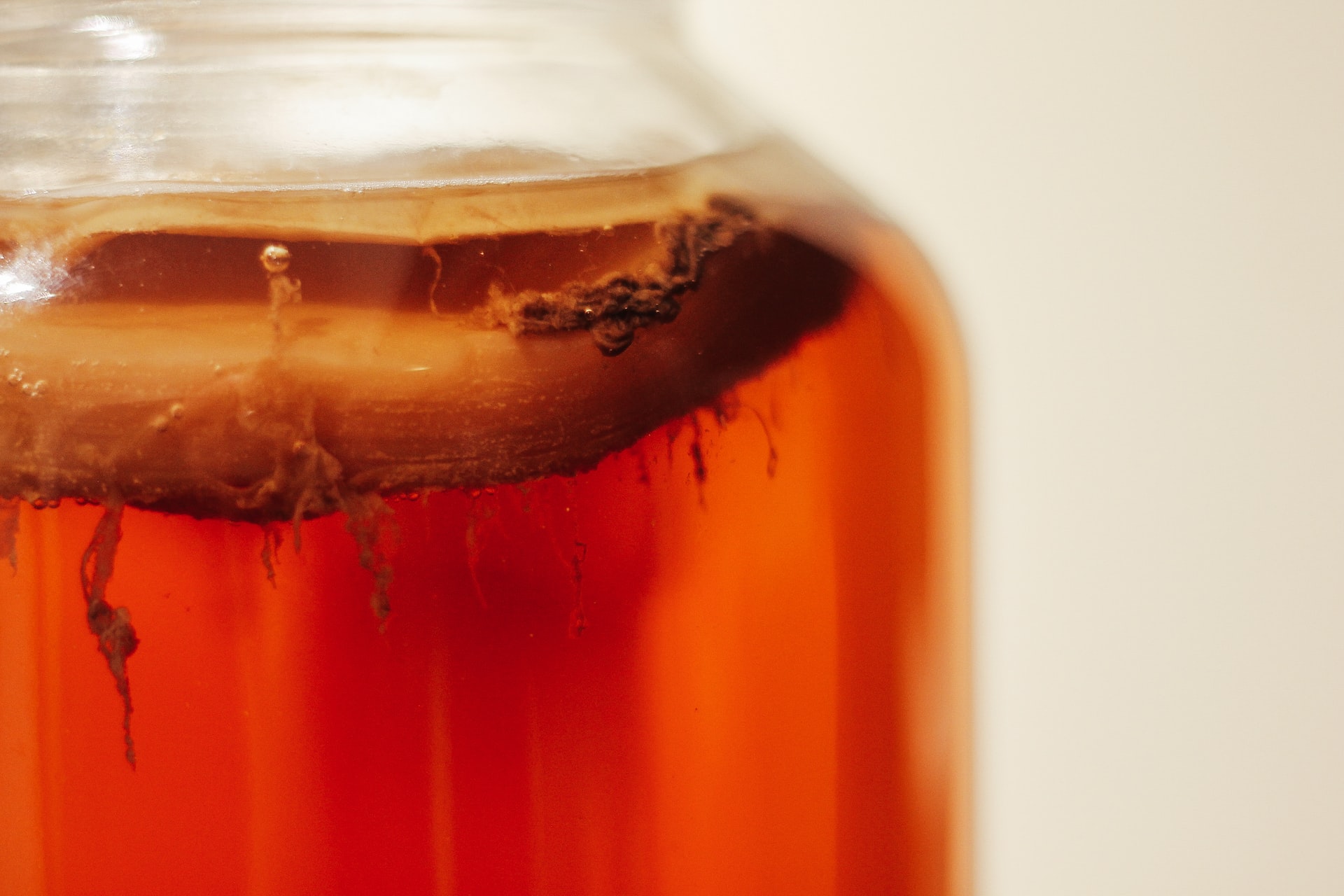When I first set out to learn how to make a kombucha SCOBY, I couldn’t wrap my head around the fact that I could grow one from practically nothing within a few weeks to a month.
Hopefully, you’re just as excited as I was to grow your first SCOBY, but if you want to brew sooner rather than later, you may consider purchasing a live starter culture to save yourself this step.
Keep reading to find out what NOT to use when growing your own SCOBY in the advanced tips section at the end.
And if you want the complete process, including first and second fermentation and flavoring, check out the complete guide here.
If you purchase a recommended product after clicking one of our links in this post, we may earn a commission.
What is a SCOBY?
It’s an acronym for Symbiotic Culture Of Bacteria and Yeast.
It is the powerhouse that turns sweet tea into fermented kombucha. Also known as a pellicle, it contains lactic acid and acetic acid bacteria, which, along with the yeast, gives kombucha its signature sour taste and smell.
Is It Safe To Grow a SCOBY From Kombucha?
Absolutely yes! It protects your kombucha during fermentation, so growing one is an essential step and highly recommended. Make sure to follow the steps outlined below, and you will have your very own SCOBY in no time.
Where Does It Grow From?
It’s just part of the brewing process. Actually, a new baby SCOBY forms with each new fermentation, so after a while, you’ll start to accumulate them if you’re brewing regularly.
In the case of making your own from scratch, it’s a combination of black tea, sugar, and store-bought kombucha (which is already fermented) that come together to create a new SCOBY from what seems like nothing.
Ingredients and Supplies
Making your own SCOBY is incredibly simple and only takes a few readily available ingredients, most of which you probably have lying around in your kitchen.
Ingredients to Grow a SCOBY
- 7 cups of filtered water
- ½ cup white cane sugar
- Four bags of black tea or one tablespoon loose leaf black tea
- One cup of unflavored, unpasteurized store-bought kombucha. I like GT’s Original
Supplies Needed to Grow a SCOBY
- A large container. It can be made from glass or ceramic (I recommend at least 1 gallon (3.7L))
- Tightly woven cloth (I cut out a circular pattern from 100% cotton dishcloths I had), but you can use coffee filters or paper towels to cover the jar
- Large pot to boil water and a wooden or plastic stirring utensil
- Rubber band
How to Make a Kombucha SCOBY
- Prepare Sweet Tea: Bring 2 cups of the water to a boil and remove from heat as the water starts a rolling boil. Dissolve sugar into it and give it a gentle stir. Add tea bags or loose-leaf tea and steep for 20-25 minutes.
- Cool to Room Temp: Take the remaining 5 cups of cool water and add to sweet tea, which should bring the mixture down to room temperature. You should shoot for a temperature between 68-85 degrees F, 20-29 C. Test with a digital thermometer, as higher temperatures can damage your SCOBY.
- Remove Tea Bags: OR completely strain the loose tea leaves from the liquid.
- Add Store-Bought Starter Kombucha: Pour your sweet tea from your pot into the fermentation jar, then pour the store-bought kombucha in, making sure to include any sediments from the bottom of the bottle if possible, as these will help kickstart the fermentation.
- Cover Jar: Cover the fermentation jar with a few layers of tightly woven cloth and secure it with a rubber band to keep bugs and other nasties out of your brew. If you don’t have anything cloth, I’d recommend using a few paper towels in a pinch.
- Ferment: Place the jar in a still place where you can maintain an average room temperature of around (70-75 degrees F, 21-24 C). Most importantly, keep the fermenting kombucha out of direct sunlight, which can hinder the SCOBY from forming and growing into a healthy culture. Your SCOBY should be ready within 1-4 weeks when a ¼ inch (½ cm) SCOBY has formed.
Advanced Tips on How To Make a Kombucha SCOBY
- Don’t use cheesecloth to cover the jar, as it’s too easy for small insects like fruit flies to get through. Opt for tightly woven cloth, paper towels, coffee filters, or napkins tightly bound by a rubber band or twine.
- Use only caffeinated black tea (Don’t use Decaf) when making your SCOBY, as it’s the most nutritious for growth. You can use different teas during the first fermentation, and most homebrewers use a 50/50 mix of black and green teas.
- A SCOBY forms best when using plain granulated white table sugar; organic is also acceptable. Don’t use honey or sugar substitutes. The former can contain botulism bacteria, and if grown exponentially, as is done when brewing kombucha, it can be dangerous! The latter just won’t provide any nutrition for your SCOBY to grow. If you’re concerned with using what seems to be a lot of sugar, just remember it’s for the SCOBY, and most will not be present in the final product.
Cheers!

